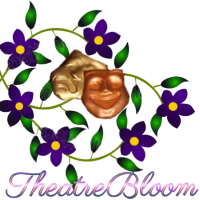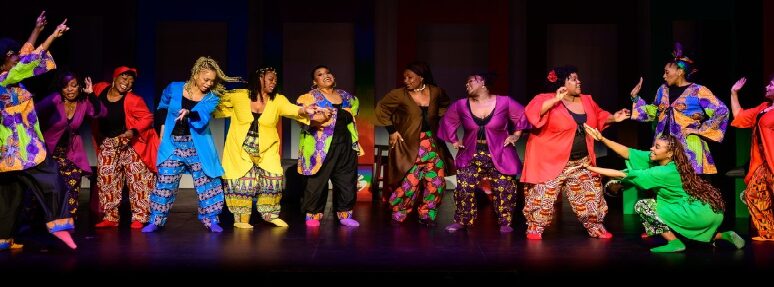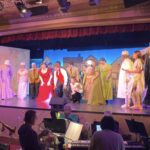author: Anthony Case
There is a lot to say about the play for colored girls who have considered suicide/when the rainbow is enuf by Nzotake Shange. The play, or choreopoem as she put it, was written in 1977 and has become a legendary text in black theater. Its exploration of the trials and joys and hardships of being both black and a woman in America has spoken strongly to black women, and has given those who are not in that demographic (such as myself) a window into that life. It’s not a show that is produced very often, so I had never seen the full show, so I was pumped to see 2nd Star’s production of the text, directed and choreographed by Rikki Howie Lacewell and with Musical Direction by LeVar Betts (who also wrote an original score to accompany the piece). Yes, there is a lot to say about the show in general, and in particular this magical production of it. But how to write about it?
Would I recommend seeing it? Absolutely. One of the cast members, Temple Fortson, expressed that she was drawn to the piece because every person can watch it and find at least one poem that speaks directly to them. And Lacewell’s sharp choreography and intimate direction only adds to that. Every move adds to the story these women are telling, and the communal nature of the production is a wonderful touch. It all feels like women around a campfire, or in group therapy, telling each other about their lives. The score by Levar Betts is an astounding work of jazz that propels the movement of these performers. Each of the songs he wrote (and he wrote songs for the majority of the poems found in the piece) fit the emotional tone of the scenes perfectly.
Technically, the show is marvelous. Set Designers Rikki Howie Lacewell and Jane B. Wingard have created a beautiful space for the action of the show. Several multicolor towers stand on the outskirts of the stage, with smaller, matching seats placed in front of them for the actors to sit on. The rest of the stage is bare. It creates a striking visual without the design getting too complicated and allows for the choreography to really shine. The lighting design by various members of The Bowie Playhouse Staff (the program does not name one as the specific designer but names several technicians for both the lights and sound) is similarly deceptively simple, yet extremely stylish. The flashier parts of the design include a back wall lit up in the colors corresponding to the speaker of the poem and some perfectly timed cues, but the majority of the design is just finding the perfect levels for each of the scenes. While many might overlook it, this is absolutely essential for quite a few scenes to work, and the team has executed to absolute perfection. Similarly, the sound design (with programming by Davis Wootton-Klebanoff and operation from Peyton Bramble and Tyler Hart) was perfect. I heard every single word spoken in the show, which is very important in a show like this. And while I might not be as experienced in sound mixing, I can say that I didn’t hear a single crackle and the levels of the live music was very impressively mixed with the vocals of the performers. Many kudos to the technical design team for such an impressive feat!
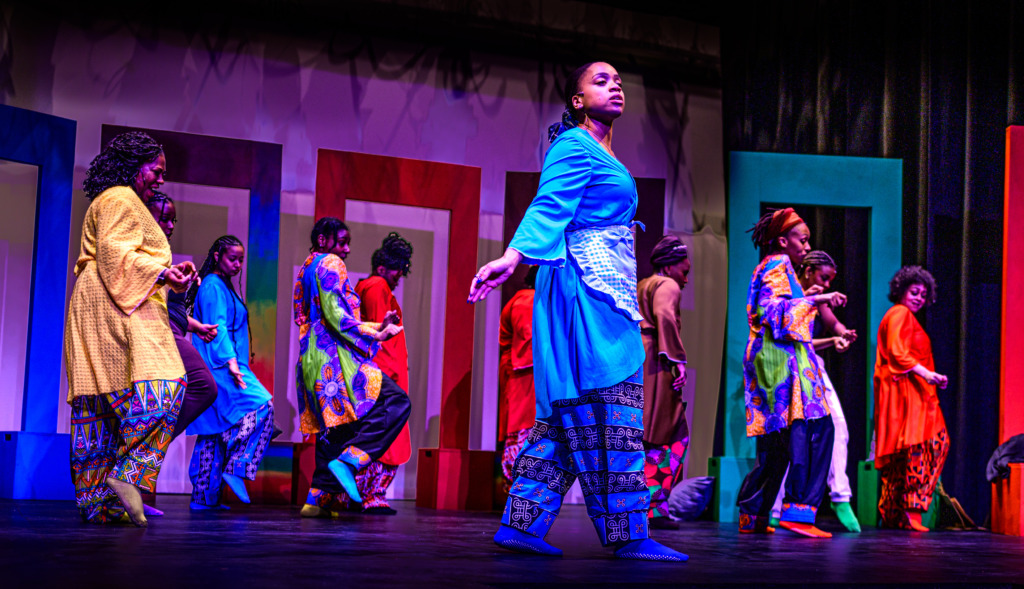
Both the Hair and Makeup by Shemika Renèe and costumes by Jeane Binney are absolutely wonderful. Renèe has thought out each of these performers’ hair styles very well, finding an appropriate hairstyle for each character that looks (at least from my perspective) very authentic while also telling the audience about their personality. I also love the beautiful eyeshadow that matches perfectly to each of Binney’s costumes. Binney has taken a rather interesting approach to the costumes in this production. Going by production stills and short videos from professional and semiprofessional productions, it looks like the show usually goes with strong, color blocked dresses or pantsuits. And while the coats Binney has provided does give off the essence of color blocking, the most visually striking part of the design are the traditional African print (I believe it would be considered Ananka) pants. This, combined with the huge variety of hair, creates a wonderful PanAfrica aesthetic in the performers.
Speaking of the performers, this is probably where I had the most issues writing this review. This is not to say any of them did a poor job. On the contrary, every one of them gave spectacular performances. I had trouble because this is not your traditional piece of theatre. There aren’t really any traditional characters or storylines. The show is a group of poems, some narrative, some expressionist, some experimental, that gives us glimpses into the lives of black women around the country. And those women are not (for the most part) given names. Instead they are represented by a group of women only differentiated by the color that they wear. Usually there is one per color: ones in brown, red, orange, yellow, green, blue, and purple. However, this production has made the decision to double-cast the ladies in red (Temple Forston and Jo Monplaisir), blue (Rowan Campbell and Vanessa McNair), and purple (Iyanu Bishop and Danielle J. Curry), and add three new characters called the ladies in Multicolor (Lauren Baker, Erin Elise Diamond, and Amariya Kailo). They also made it very hard to follow along in the program, as the poem and song list was written on a dark orange insert with black lettering, making reading it (and potentially taking notes, in my case) very hard. Do I think this is ultimately a bad choice? No, I think that helps the audience not worry about following along and just get immersed in the stories told. But it does make me more reliant on my memory, which is good, but not perfect. If I make any mistakes in giving credit, my apologies in advance.
As I said, each of these ladies give amazing performances, and each have their own standout moments within the show. As the Lady in Brown, Dionne Belk’s performance of “toussaint” shows her off as an amazing storyteller, who really can dive into the nuances of such a complex piece. As the aforementioned Ladies in Red, Fortson shows a quiet strength in “no assistance” while Monplaisir is able to add a lot of depth to the unnamed main character in “one.” This comes together beautifully in arguably the centerpiece of the show “a nite with beau willie brown.” I don’t want to give too much away for this poem, but keep tissues close. As the Lady in Orange, Cheramie J Jackson is a key reason why that piece works as powerfully as it does, and her “I’m a poet who” gives the audience a necessary burst of optimism (even with some dark undertones to this poem). Sonja Dinkins as the Lady in Yellow has a heartbreaking part in “no more love songs,” which contrasts beautifully with her other big moment “graduation nite.”
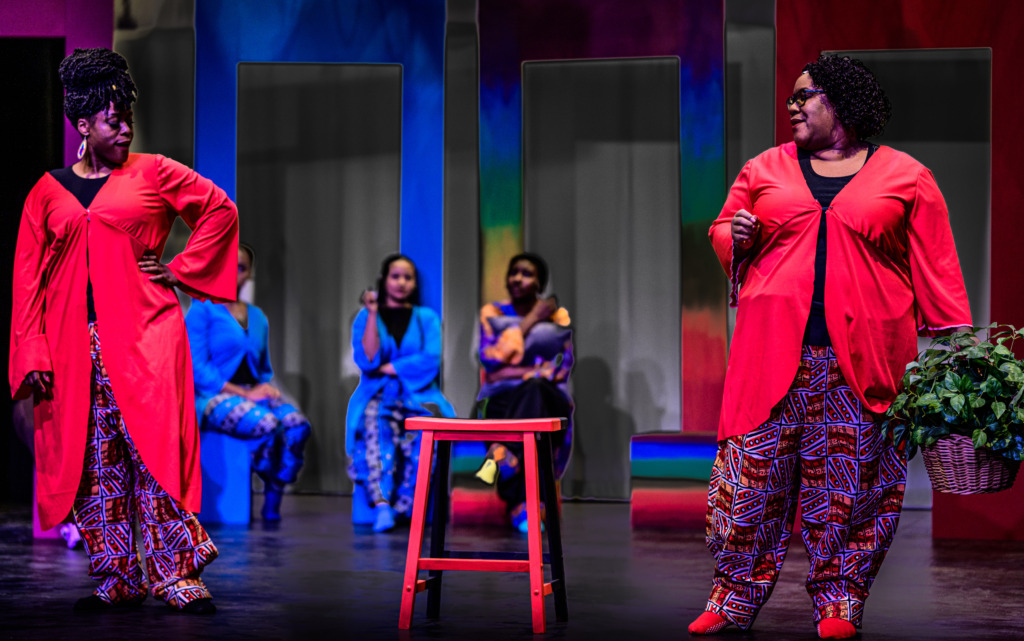
As the Lady in Green, Imani Corbin has what might be the most difficult poem to pull off in “somebody almost just walked off wid alla my stuff.” The writing is repetitive in a way that would almost certainly make it very hard to memorize, and the unnatural cadence and broad emotional themes can lead a performer to deliver it in a way that is somewhat forced and pretentious. Corbin, though, delivers it in a righteously furious tone, making all the odd markings of the poem seem entirely natural. A skilled technical dancer, Vanessa McNair as one of the Ladies in Blue delivers a heartbreaking monologue in “abortion cycle #1.” The other Lady in Blue, Rowan Campbell, gives a beautiful eulogy for a past self in “I usedta live in a world.” The Ladies in Purple, Iyanu Bishop and Danielle J Curry, usually move as a tight knit group (similarly to the Ladies in Multicolor, Lauren Bake, Erin Elise Diamond, and Amariya Kailo). Whether they are coming together to celebrate a beautiful dancer in “sechita” or acting as scorned romantic rivals in “pyramid,” the two are spectacular in finding moments of perfect synchrony. The Ladies in Multicolor act to push the story forward very well. They don’t have big moments, like some of the other cast members, but they are invaluable to the pace of this production, and their inclusion adds to the idea that these women are, of course, more than just one color.
Every now and then, you see a show that really takes your breath away. One that makes you sit there, contemplating the world in a different way after seeing it. I suppose that’s why I struggled writing this one. It rearranged me in a way that I had to find myself again. And I am very glad for it. Go see 2nd Star’s production of for colored girls who have considered suicide/when the rainbow is enuf. You will be glad you did.
Running Time: Approximately 90 minutes with no intermission
for colored girls who have considered suicide/when the rainbow Is enuf plays through March 1st 2025 2nd Star Productions in residence at at Bowie Playhouse— 16500 White Marsh Park Dr in Bowie, MD. Tickets are available by calling the box office at 301-805-0219 or by purchasing them in advance online.
